Container Sizes
We frequently get questions about the different container sizes available on our website. On every product page, the detail about the plant you are considering includes specific information about “container” size, unless it is shipped bare root.
Plants are shipped in 2.5-inch to 1-gallon individual pots with minimum quantities, 3.5-inch pots in (18) count trays, 4-inch and 1-quart pots in (10) count trays or in (20) or (30) count plug trays. (72) count and (128) count trays may be available upon request.
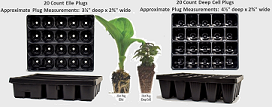
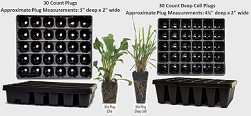
Early spring plants may be shipped in a dormant state and plant size may differ based upon the time of year and pruning. Larger plants are sometimes trimmed before being packed for shipping, which allows larger plants to fit without breakage and conserve energy during transportation and transplanting.
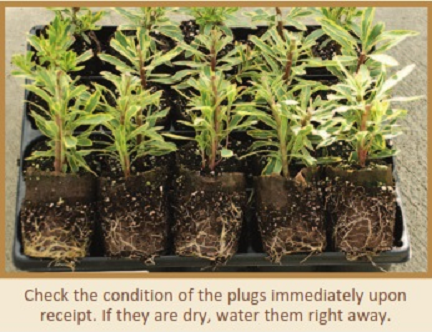
We guarantee your plants will arrive alive, healthy and in good condition. Whether shipped in an active growing state, or during dormancy, successful delivery is essential to customer satisfaction. Boxed plants are carefully packed and rooted well enough to minimize movement of the plants during shipping (optimistically) regardless of how many times UPS or FedEx flips the box.
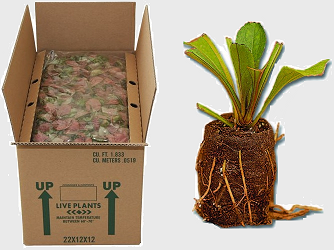
The Ellepot
The Ellepot paper holds the growing medium together, thereby protecting the roots and naturally degrades once planted, there is no need to remove the paper during planting. Planting Elle plugs -
Planting — Plugs are easy to transplant by hand. Gently grip the plant by the crown, and slowly lift the plug out of the tray. The air space between the paper sleeve and the tray makes the plug much quicker and easier to transplant than traditional plugs.
The Paper Sleeve — The paper sleeve around the plug will degrade naturally, so there is no need to remove it. It makes transplanting much easier and also helps to maintain the integrity of the root ball. This results in less transplant shock and more uniform growth for the plants.
Potting Soil — Use a well-drained potting soil which contains 40%-60% bark content.
Planting level — When planting Elle Plugs, the top of the Elle Plug should be about ¼” below the soil line.
The root ball of the twenty count flat Elle plug is 2.75" wide and 3.25" tall. The root ball of the thirty count flat Elle plug is 2" wide and 3" tall. The size of the plants of both sizes depends on individual plant characteristics.
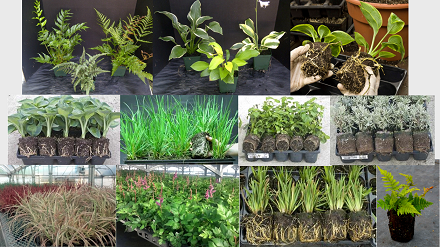
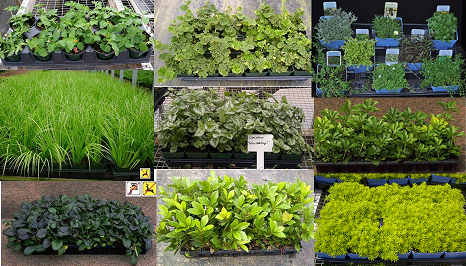

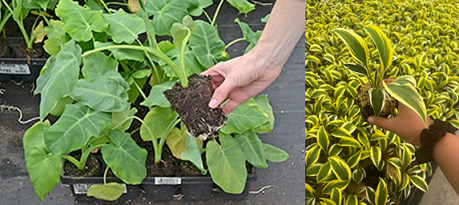
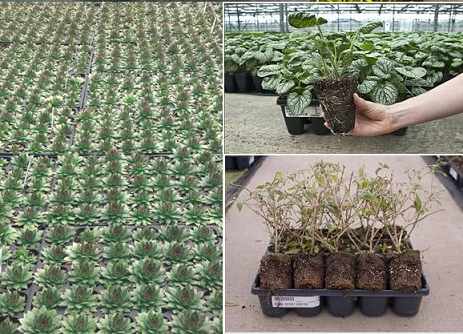
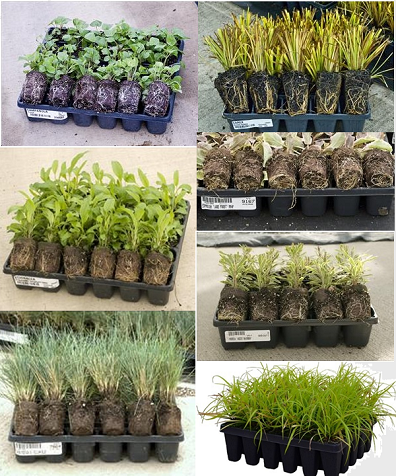
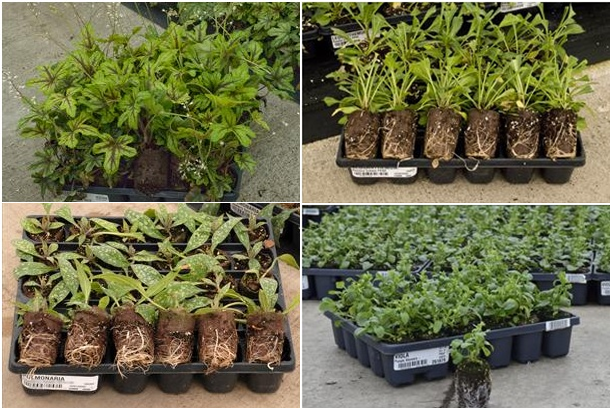
Transplanting plant tray plugs is a crucial step in giving your young plants a strong start. Here is a general guide to help you successfully transplant those little guys:
1. Timing is Key:
- Ideal Timing: Most plugs are ready to transplant when they have a couple of sets of true leaves and a well-developed root system (you might see roots peeking out of the drainage holes).
- Urgent Cases: If the plugs become root-bound (roots circling tightly in the cell), transplant immediately to prevent stunted growth.
2. Prep Work:
- New Home: Choose a slightly larger container (like a 4-inch pot) or prepare your garden bed.
- Soil Matters: Use a well-draining potting mix for containers or amend garden soil with compost for better drainage and fertility.
- Moist is Best: Water the plugs and the new soil about an hour before transplanting to reduce stress.
3. Gentle Handling:
- Loosening Up: Gently squeeze the bottom of the plug tray or use a small tool to help loosen the plugs.
- Handle with Care: Hold the seedlings by their leaves or the root ball, not the delicate stems.
4. Planting Depth:
- Just Right: Plant the plugs at the same depth they were in the tray. Burying the stems can lead to rot.
5. Settling In:
- Water Well: Water thoroughly after transplanting to help settle the soil and eliminate air pockets.
- Provide Support: If the seedlings are leggy, provide support with stakes or a small trellis.
6. Acclimate Gradually (if going outdoors):
- Hardening Off: Gradually introduce your seedlings to outdoor conditions over a week or two before planting them in the garden. This helps them adjust to sunlight, wind, and temperature fluctuations.
7. Ongoing Care:
- Consistent Moisture: Keep the soil consistently moist but not soggy.
- Monitor for Pests: Check regularly for pests and diseases and take action promptly if needed.
Extra Tips:
- Label Clearly: Label your seedlings to keep track of varieties.
- Spacing Matters: Space plants according to their mature size to allow for adequate airflow and growth.
- Consider the Weather: Avoid transplanting during extreme heat or cold.
By following these steps, you will give your plant tray plugs the best chance to thrive in their new environment!
Landscaping with plugs versus gallon containers is a strategic decision with significant benefits that extend beyond initial cost savings. While gallon containers offer mature plants for immediate impact, plugs provide a compelling case for long-term success and sustainability.
Plugs are a testament to the power of potential energy in the plant world. These young plants, though small in stature, are energy-efficient powerhouses. They harness the sun's energy through photosynthesis and store it as carbohydrates, creating a reserve that fuels rapid growth once transplanted into the soil. This stored energy enables plugs to quickly develop roots and foliage, often catching up to the size of larger, mature plants within a single growing season under optimal conditions. This accelerated growth is particularly advantageous in projects where quick establishment and coverage are priorities.
The rapid growth of plugs is attributed to several factors:
- Efficient Energy Storage: Plugs are highly efficient at converting sunlight into energy, maximizing their photosynthetic potential.
- Compact Root Systems: Their smaller root systems allow for faster establishment in the new planting site, as they do not have to expend as much energy on root development.
- Reduced Competition: In plug trays, seedlings have minimal competition for resources, allowing them to focus on individual growth and development.
This rapid growth potential makes plugs an ideal choice for landscapers seeking to achieve a mature look in a shorter timeframe. They can be used to fill in gaps in existing plantings, create new borders and foundation plantings, or establish large-scale landscapes quickly and efficiently.
Choosing plugs in landscaping projects goes beyond mere financial prudence. It is a commitment to sustainable practices that benefit both the environment and the long-term health of the landscape. By opting for plugs, landscapers contribute to:
- Reduced Water Usage: In an era of increasing water scarcity, utilizing plants with lower water requirements is essential for responsible landscaping. Plugs, with their smaller size and efficient root systems, require less frequent and less abundant watering compared to larger plants in gallon containers. This conservation of water resources is especially crucial in arid or semi-arid regions where water availability is limited.
- Minimized Fertilizer Use: Lower fertilizer needs translate to reduced runoff and pollution of waterways, protecting ecosystems, and promoting healthier environments. Plugs, with their efficient nutrient uptake, require less frequent and less concentrated fertilization compared to larger plants. This reduced fertilizer use helps to maintain soil fertility and minimize the risk of nutrient leaching into nearby water bodies.
- Enhanced Biodiversity: The affordability of plugs allows for greater plant diversity in a landscape, creating more resilient and ecologically balanced green spaces. By choosing a wider variety of plant species and cultivars, landscapers can create more complex and diverse ecosystems that support a greater range of pollinators, birds, and other beneficial organisms. This increased biodiversity contributes to the overall health and resilience of the landscape.
In conclusion, while gallon containers offer instant gratification, plugs present a compelling blend of economic and environmental advantages. Their rapid growth potential, cost-effectiveness, and reduced resource consumption make them a strategic choice for sustainable landscaping that balances financial considerations with ecological responsibility.
